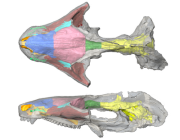Citation:
Abstract:
The currently accepted description of the pattern of electromyographic (EMG) activity in the pharyngeal swallow is that reported by Doty and Bosma in 1956; however, those authors describe high levels of intramuscle and of interindividual EMG variation. We reinvestigated this pattern, testing two hypotheses concerning EMG variation: 1) that it could be reduced with modern methodology and 2) that it could be explained by selective detection of different types of motor units. In eight decerebrate infant pigs, we elicited radiographically verified pharyngeal swallows and recorded EMG activity from a total of 16 muscles. Synchronization signals from the video-radiographic system allowed the EMG activity associated with each swallow to be aligned directly with epiglottal movement. The movements were highly stereotyped, but the recorded EMG signals were variable at both the intramuscle and interanimal level. During swallowing, some muscles subserved multiple functions and contained different task units; there were also intramuscle differences in EMG latencies. In this situation, statistical methods were essential to characterize the overall patterns of EMG activity. The statistically derived multimuscle pattern approximated to the classical description by Doty and Bosma (Doty RW, Bosma JF. J Neurophysiol 19: 44-60, 1956) with a leading complex of muscle activities. However, the mylohyoid was not active earlier than other muscles, and the geniohyoid muscle was not part of the leading complex. Some muscles, classically considered inactive, were active during the pharyngeal swallow.
